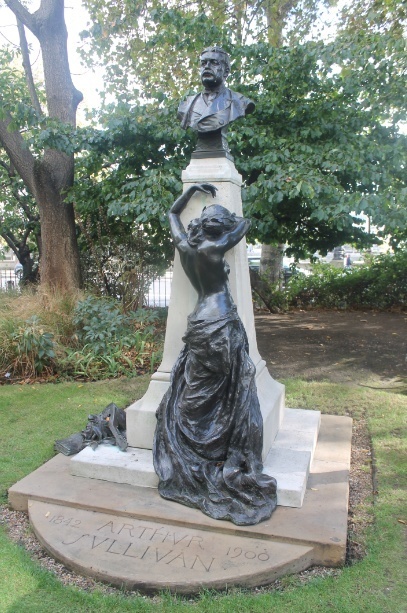Racy nudes are stood and sprawled all over London.
Michelangelo's David, the V&A

"The embodiment of youthful perfection standing languidly butt naked after defeating the evil giant Goliath, his tight buns mesmerising in the Florentine sun." Artist Liz Charsley-Jory foams at the mouth when talking about the plaster cast of David, in the V&A's Cast Courts. Indeed, we featured it in our piece on the best bums in London's museums and galleries.
It is some irony that the 'tiny' David is realised in such biblical proportions here. While his manhood may be smallish in relation to the rest of his body, it's also not much smaller than your head. Food for thought.
Arthur Sullivan memorial, Embankment

Ever been so mournful that most of your clothes fall off? Such is the distress of the muse who weeps at the bust of Arthur Sullivan in Embankment Gardens. The woman's naked form — cheeky glint of bum crack and all — is out of whack with the suited, straight-laced bust of he whose operas enjoyed wild success at the nearby Savoy Theatre.
The girl is supposed to represent music (minimalist music, judging from her attire). But though memorial aficionados London Remembers insist she "isn't just a sexy, topless Art Nouveau floozy," they also admit this is often considered the sexiest statue in London.
This still from the 1953 film The Story of Gilbert and Sullivan — in which Gilbert visits the memorial to his late partner — provides another angle on our supple subject. Christ, that moustache.

Echo, outside City Thameslink

Stephen Cox is the apt name of the artist behind Echo — a duo of well-endowed torsos that face-off in Fleet Place, by City Thameslink. No place for embellishments like faces here — only the rude bits make the cut. Next time a Thameslink service causes you to lose your head, here's some perspective; these poor souls never had a head in the first place.
Broadgate Venus, Broadgate

To paraphrase Morrissey, some statues are bigger than others. Five tonnes of polished brass make up the shapely Broadgate Venus. Its Colombian creator, Fernando Botero, is famed for his shapely goddesses. The supine figure — a cross between Alfred Hitchcock and the woman who used to gatecrash the Morecambe and Wise show — taunts us in a strategically-placed gown. One in the eye for all those sculptors of impossibly lithe female nudes.
Eric Gill's/Jacob Epstein's shrinking penises, Broadcasting House and 55 Broadway

Sculptor Eric Gill's personal life doesn't bear much thinking about, involving, as it did, sex with his sisters, daughters and dog. The controversy of the man bled into his work: when his sculpture of Ariel and Prospero was revealed on the front of Broadcasting House in 1933, the size of the sprite's genitalia was deemed too generous. Claims that Gill — or even Lord Reith himself — modified the penis are not substantiated.
Jacob Epstein's sculptures of Day and Night at TfL's headquarters in St James have a similar story. We documented it in this video:
Navigation, Trinity Square

There are scores of naked-breasted beauties in London. But this figure, at the former Port of London Authority building in Trinity Square, has an insouciance about the way she displays hers. It's like she's hitched up her top, sighed "you've got five seconds" and been frozen that way ever since. The statue is entitled Navigation, although you won't need a compass to find her globes.
Alison Lapper Pregnant, The Fourth Plinth

"Rather ugly"; "just a rather repellent artefact". That's how the statue of the naked, pregnant artist Alison Lapper was described by some when it turned up in Trafalgar Square in 2005.
'Racy' probably isn't the right word here — this Marc Quinn artwork was more controversial than anything else. We'd side with the Disability Rights Commission, who called it "powerful and arresting."
Achilles, Hyde Park

The fig leaf that covers the modesty of the ripped Achilles in Hyde Park wasn't always there. Soon after the statue was unveiled in 1822, papers across the country cried scandal over the flaunting of the Greek hero's manhood. Such as in this prudish edition of the Berkshire Chronicle, dated 29 October 1825:

The paper's claim that "the ladies of England had nothing to do with this brazen form" is grossly misinformed. Achilles was commissioned by a society named The Ladies of England.
Men appreciated it too: Larry Olivier famously quipped it had "the best arse in London".
Which London statue sets your heart fluttering? Tell us in the comments.




